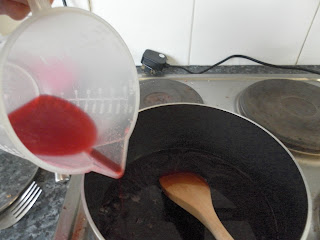Ingredients
500g raspberries
300ml cider vinegar
Granulated sugar
This amount will give you a small batch to start with so unless you have mountains of raspberries to use and nothing to do with them (I would suggest making raspberry jam if this is the case) then I would try it small scale first to check that you like it and have occasion to use it. The vinegar does keep for about a year so I think I'll be making some more when I run out.
Of course ideally you would use raspberries from your garden or allotment but as you will see from the time of year I didn't! Doing trial runs with small quantities however means that when you do have an excess of produce you will know exactly what to do with it and will have all the 'kit' handy. Raspberries are in season in the UK from July to November as there are summer and autumn varieties.
You will also need:
Jelly bag or muslin (you can get these in cooking shops for a few quid)
Sterilised glass bottles with caps (sterilise in the same way as the jars in my homemade chutney post)
A funnel
I used a couple of glass jars that had posh lemonade in that took 350ml as they were a nice shape and colourless to let the pretty colour of the vinegar show. If you were making a large batch you could use wine bottles.
 |
| Straining the fruit vinegar through a jelly bag |
Method
- Crush the raspberries lightly with a wooden spoon in a large bowl
- Add the vinegar
- Cover the bow and leave in a cool place for 4 days
- Pour the contents of the bowl through a scaled jelly bag (this means you pour boiling water through it first)
- After half an hour squeeze it to get most of the juice through then discard the raspberries
 |
| Adding the fruit vinegar to sugar in a pan |
- Measure the liquid and add 225g sugar for every 300ml
 |
| Bringing to the boil |
- Bring to the boil over a low heat, stirring gently for about 10 minutes
 |
| Bottling |
- Remove from the heat and leave to cool before bottling through a funnel
If you are giving the fruit vinegar as a gift, cut out a circle of brown paper using the rim of a large mug as a template and secure it over the bottle cap with some pretty wool or rustic looking twine. Fill out a label and stick it on the bottle.
I used some of my first batch drizzled over an avocado, beetroot and goat's cheese salad and found that nothing else was needed in the dressing. The vinegar could be mixed with a little oil however.
 |
| Avocado, beetroot, goat's cheese and lettuce with homemade raspberry vinegar |














